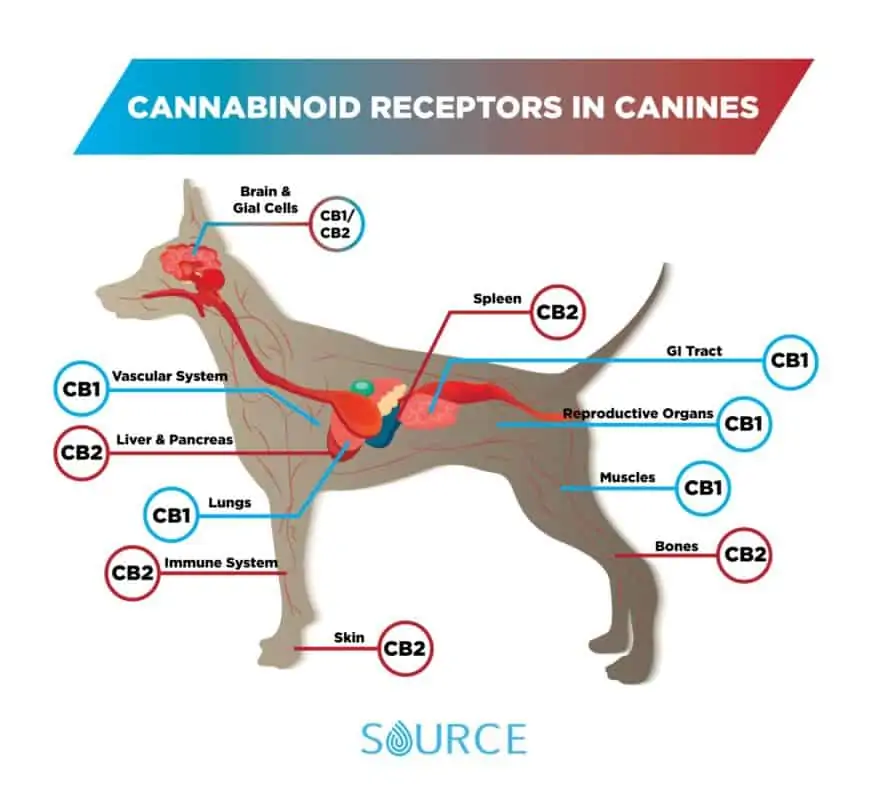CBD Oil for Pets
The Canine Endocannabinoid System: What Happens When You Give Your Dog CBD?
Have you ever wondered why CBD is beloved by pet owners? Why so many report seeing awesome results when they give it to their pets?
Or how it can work so well for both humans and animals?
It’s because of that fancy system in their bodies – the same one we have in ours…
Today we’re talking about the Canine Endocannabinoid System!
The Canine Endocannabinoid System
Just like us, our dogs have an intricate system that runs throughout the body. This system is called the endocannabinoid system (ES), and it’s actually found in almost all animals!
Scientists discovered the endocannabinoid system in the mid-1990s, and with new focus on CBD in the last few years, research into this fascinating and clinically useful system is advancing rapidly!
The canine endocannabinoid system (the ES in general) is made up of different cannabinoid receptors.
These receptors are classified in two distinct categories – CB1 and CB2 – and they’re found all throughout your dog’s body – in the brain, the major organs, the bones, the skin, and the immune system.

The main goal of the ES is bring about homeostasis (balance) in the body. These receptors play a role in various functions, including things like:
- digestion
- immune system health
- pain management
- mood and well being
- reproduction
- emotional reactivity
- neurogenesis (making new nerve cells)
- brain development
- sleep
Cannabinoids like CBD have an effect on the ES. When you give your dog CBD, those receptors are impacted, eliciting a response.
Here’s an example when it comes to pain: CB1 receptors exist on nerve fibers outside of the central nervous system and communicate with the brain. Cannabinoids stimulate CB1s on pain sensory neurons. This impacts how your dog feels (or doesn’t feel) pain!
The Endocannabinoid System and Disease
A great deal of research has been done on the links between the endocannabinoid system and disease. This includes both how disease affects the ES as well as how altering it can impact disease.
For example, it’s well known that inflammation is at the root of many diseases and health conditions in both humans and animals. And this has a lot to do with the immune system.
The immune system is regulated by the immunomodulatory effect of the endocannabinoid system. This means the ways in which the ES adjusts the immune system to, as we mentioned, bring about balance.
Immune system cells have the cannabinoid receptor CB2 on their cell membranes. According to research, these CB2 receptors help bring about a healthy response to inflammation in the body by up-regulating several anti-inflammatory pathways, including the inhibition of T-cell pro-inflammatory activity.
So, when your pup is not feeling their best, it could be because their ES is out of whack. Working on the cannabinoid receptors may help get things back in tip-top shape.
How to Boost the Health of Your Dog’s ES
You may be thinking CBD is the way to boost the health of your dog’s (and your own) ES. And that’s true.
But it isn’t the only way.
There are actually lots of ways to support the ES naturally. Many of these are easy – and you probably do them every day.
- Exercise – get out there and toss the ball, do some agility, or go for a nice walk.
- Probiotics – a specific strain of probiotic, lactobacillus acidophilus, increases the activity of CB2 receptors.
- Reduce Stress – stress has a negative impact on the ES, so helping your dog relax and feel secure is a great way to support it.
- Omega-3 fatty acids – your dog can’t produce these essential fatty acids on their own, so add some to their diet.
- Sunshine – UVA rays from the sun promote nitric oxide activity in the body. Nitric oxide boosts the number and expression of CB1 receptors.
The canine endocannabinoid system is an amazing thing. Making sure it’s healthy is a great way to boost your dog’s overall health!

